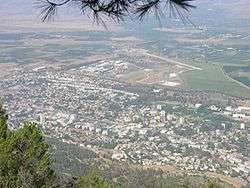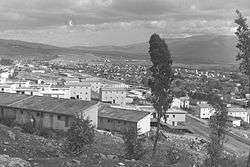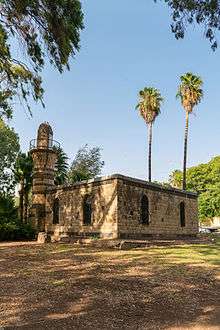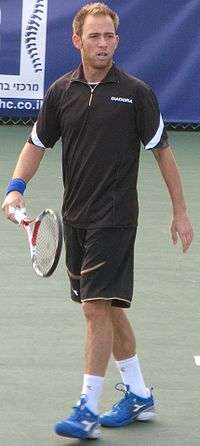Kiryat Shmona
Kiryat Shmona (Hebrew: קִרְיַת שְׁמוֹנָה, lit. Town of the Eight) is a city located in the Northern District of Israel on the western slopes of the Hula Valley near the Lebanese border. The city was named after the eight people, including Joseph Trumpeldor, who died in 1920 defending Tel Hai.
Kiryat Shmona
| |
|---|---|
| Hebrew transcription(s) | |
| • ISO 259 | Kiryat Šmona |
| • Also spelled | Kiryat Shemona (official) |
 View of Kiryat Shmona from Manara cliffs | |
 Coat of arms of Kiryat Shmona | |
 Kiryat Shmona  Kiryat Shmona | |
| Coordinates: 33°12′27″N 35°34′11″E | |
| Country | |
| District | Northern |
| Founded | May 1949 |
| Government | |
| • Type | City (from 1975) |
| • Mayor | Avihay Shtern |
| Area | |
| • Total | 9,960 dunams (9.96 km2 or 3.85 sq mi) |
| Population (2018)[1] | |
| • Total | 22,625 |
| • Density | 2,300/km2 (5,900/sq mi) |
| Postal code | 12100 |
| Name meaning | Town of Eight |
In 2018 it had a population of 22,625,[1] the majority of whom are Jews, particularly of Moroccan extraction. Located near the Israel-Lebanon border, Kiryat Shmona is Israel's northernmost city.
History
Foundation (1949)
The town of Kiryat Shmona was established in 1949[2] on the site of the former Arab village al-Khalisa, whose inhabitants had fled after Safed was taken by the Haganah during the 1948 Arab–Israeli War and an attempt by the village to come to an agreement with the Jewish authorities was rejected.[3] Literally The town of the Eight, Kiryat Shmona was named after eight Jewish militiamen, commanded by Joseph Trumpeldor, who had fallen in the 1920 Battle of Tel Hai during the Franco-Syrian War adjacent to the new town. It had originally been named Kiryat Yosef for Trumpeldor before the name was changed to Kiryat Shmona in June 1950.[4]
Initially the empty houses of Khalisa were used as a transit camp for Jewish immigrants and refugees who worked mainly in farming. It was called Kiryat Yosef after Yosef Trumpeldor. The first residents were fourteen Yemenite Jews who arrived on July 18, 1949 and were followed by more Yemenite Jews a month later. By July 1951, the population had grown to nearly 4,000.[4] Relationships with nearby kibbutzim were often strained.[4]
In 1953, Kiryat Shmona become a development town.[5] In the first few years, the town's growth was driven by the arrival of immigrants from Yemen and Romania, but later on, waves of immigrants from North Africa, in particular from Morocco, arrived. The city was built without a master plan, but rather neighborhood by neighborhood as waves of immigrants arrived.
Later years (1950–present)

Kiryat Shmona's location close to the Lebanon makes it a rich target for rocket fire cross-border attacks.
On April 11, 1974, the Popular Front for the Liberation of Palestine – General Command, sent three members across the border from Lebanon to Kiryat Shmona. They killed eighteen residents of an apartment building, including many children, before being killed in an exchange of fire at the complex, which became known as the Kiryat Shmona massacre.[6]
The city continued to be the target of attacks after this, including Katyusha rocket attacks by the PLO in July 1981,[7] a Katyusha rocket attack by the PLO in March 1986 (killing a teacher and injuring four students and one adult),[8][9][10] and further Katyusha rocket attacks by Hezbollah during 1996's Operation Grapes of Wrath.[11] The citizens of the town had suffered almost daily attack from the mid-1970s until 2000, when the IDF left Lebanon.
In spite of attacks from Lebanon, the town steadily grew. It had a population of 11,800 in 1972, which grew to 15,100 in 1983.
In the years 2000–06, the locals enjoyed relative peace but suffered from loud explosions every few weeks because of Hezbollah anti-aircraft cannons fired at IAF planes flying across the Israeli-Lebanese border.
During the 2006 Lebanon War, the city was again the target of Hezbollah Katyusha rocket attacks. Most of the city's residents left the area during the war, and the 5,000 who remained stayed in bomb shelters, turning the city into a ghost town.[12] During the war, a total of 1,012 Katyusha rockets hit Kiryat Shmona.
Geography
Kiryat Shmona is located in the Finger of the Galilee next to the Hula Valley, about 5 kilometres (3 miles) south and 2 km (1 mile) east of the Israel–Lebanon border. Its elevation is about 150 metres (492 feet) above sea level.[2]
Earthquakes
The city is located above the Dead Sea Transform fault, and as a result, is one of the cities in Israel most at risk to earthquakes (along with Safed, Beit She'an, Tiberias, and Eilat).[13]
Demographics
According to CBS, in 2001 the ethnic makeup of the city was 97.9% Jewish and other non-Arabs, without a significant Arab population. In 2001 there were 121 immigrants. The Jewish population of the town is largely of Sephardi and Mizrahi heritage, and many are industrial workers employed in local small industry and in neighboring kibbutzim.
According to CBS, in 2001 there were 10,800 males and 10,700 females. The population of the city was spread out with 33.5% 19 years of age or younger, 19.8% between 20 and 29, 19.3% between 30 and 44, 15.3% from 45 to 59, 3.5% from 60 to 64, and 8.5% 65 years of age or older. The population growth rate in 2001 was 1.8%.
Economy
Income
According to CBS, as of 2000, in the city there were 8,303 salaried workers and 467 are self-employed. The mean monthly wage in 2000 for a salaried worker in the city is 4,306 shekels, a real change of 4.6% over the course of 2000. Salaried males have a mean monthly wage of 5,443 shekels (a real change of 7.1%) versus 3,065 shekels for females (a real change of −2.2%). The mean income for the self-employed is 6,769. There are 564 people who receive unemployment benefits and 1,655 people who receive an income guarantee.
Industry

Kiryat Shmona has diverse economic activities among its inhabitants. The town's economy is based on both light industry, involving consumer-oriented products such as communications, information technology, and electronics as well as agriculture on the surrounding lands and tourism.
Tourism
The town has a cable car link with Manara above in the Naftali mountain range and also is home to an activity center and toboggan run located in the south of the town.

In the residential area there is an urban natural space called Park HaZahav. Zahav means "gold" in Hebrew; the park is named after the stream running through it – Ein Zahav Stream – the source of which is Ein Zahav ("golden spring"). Park HaZahav covers 11 hectares in the middle of the city. It comprises many diverse natural resources. In addition to intensive activity areas designated for leisure and play, and open to all, the park contains a diverse, protected, natural area comprising Ein Zahav Stream and HaTachanot Stream (Tachanot refers to two water mills [tachana=mill] which were active along this stream in the past), which flow through the middle of the park. These streams have created different aquatic habitats, including shallow sections, rapids, deep sections and pools that support diverse riparian vegetation that has developed with time into a riparian forest. This isn't common in Israel. The park has a trail that goes through the forest and along the stream. Included in the park are different gardening initiatives by local volunteers, a picnic area, and a playground. The park is used for educational purposes by the community.
Education
According to CBS, there are 12 schools and 4,339 students in the city. They are spread out as 9 elementary schools and 2,355 elementary school students, and 6 high schools and 1,984 high school students. 49.3% of 12th grade students were entitled to a matriculation certificate in 2001.
The Tel-Hai Academic College is a college located near Kibbutz Kfar Giladi and north of Kiryat Shmona. The college offers academic and continuing education programs for approximately 4,500 students, 70 percent of whom come from outside the Galilee. Minorities comprise about 10 percent of the student body. The college offers degrees in life sciences, social sciences, computer science and the humanities.
Sport
Kiryat Shmona is the smallest city in Israel with a top flight football club, Hapoel Ironi Kiryat Shmona. Formed by a merger of Hapoel Kiryat Shmona and Maccabi Kiryat Shmona in 2000, the club won promotion to the top division for the first time at the end of the 2006–07 season, and won the Israeli Premier League Championship in 2011–2012.
Tennis is also part of the Kiryat Shmona sport scene. The town is home to one of the 14 Israel Tennis Centers (ITC). These Centers throughout Israel teach children life skills through tennis. The Centers are primarily funded through donations. The Israel Children's Centers in the United States, and the Canada Israel Children's Centres are largely responsible for the funding of the Tennis Centers, which strive to never turn a child away due to financial need.

Notable residents
- Vladislav Bykanov (born 1989), Olympic speed skater
- Zephaniah Drori (born 1937), Chief Rabbi of Kiryat Shmona
- Dudi Sela (born 1985), tennis player
- Artem Tsoglin (born 1997), pair skater
- Eden Ben Zaken, singer
- Ronald Zilberberg (born 1996), Olympic figure skater
Twin towns
Kiryat Shmona is twinned with:
.svg.png)



References
- "Population in the Localities 2018" (XLS). Israel Central Bureau of Statistics. 25 August 2019. Retrieved 26 August 2019.
- Vilnai, Ze'ev (1979). "Kiryat Shmona". Ariel Encyclopedia (in Hebrew). Volume 7. Israel: Am Oved. pp. 7111–12.
- Morris, Benny (2004). The Birth of the Palestinian Refugee Problem Revisited. Cambridge University Press. pp. 250–251.
- Amir Goldstein (2016). "The kibbutz and the ma'abara (transit camp): The case of the Upper Galilee kibbutzim and Kiryat Shmona, 1949–1953". Journal of Israeli History. 35: 17–37. doi:10.1080/13531042.2016.1140878.
- HaReuveni, Immanuel (1999). Lexicon of the Land of Israel (in Hebrew). Miskal – Yedioth Ahronoth Books and Chemed Books. p. 852. ISBN 978-965-448-413-8.
- "Modern Israel & the Diaspora (1970–1979)". Jewish Virtual Library. Retrieved September 29, 2008.
- "The Daily News – July 1981". The Eighties Club. Retrieved September 29, 2008.
- "Yearbook of the United Nations 1986 – Volume 40". United Nations. December 31, 1986. Archived from the original on April 24, 2008. Retrieved September 29, 2008.
- "World Notes Middle East". Time Magazine. April 7, 1986. Retrieved September 29, 2008.
- Friedman, Thomas L. (March 28, 1986). "New Rocket Casualties". New York Times. Retrieved September 29, 2008.
- "The History Guy: The Israel-Lebanon Conflict (1978–present)". Retrieved September 29, 2008.
- Slier, Paula (2006-07-20). "An eerie silence in Kiryat Shmona". Jpost.com. Retrieved 2013-03-26.
- Experts Warn: Major Earthquake Could Hit Israel Any Time By Rachel Avraham, staff writer for United With Israel. Date: Oct 22, 2013
External links
| Wikimedia Commons has media related to Kiryat Shmona. |
| Wikivoyage has a travel guide for Kiryat Shemona. |
- Places To Visit in Kiryat Shmona (English)


